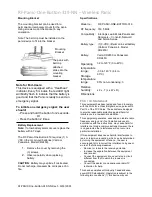
RF-Panic-One-Button-319-NN – Wireless Panic
RF-PANIC-One-Button-319-NN Rev.5 10/4/2021
Mounting Bracket
The mounting bracket can be used for a
permanent or temporary mount for the panic.
Using screws mount the bracket in any
orientation.
Note: The belt clip must be installed on the
panic device to fit into the bracket
Mounting
Bracket
The panic with
belt clip
attached
slides into the
mounting
bracket
Note for End-Users:
This device is equipped with a “Heartbeat”
indicator. Every 5 minutes the red LED light
will briefly flash to indicate that the battery is
good and that the Panic is ready to send an
emergency signal.
To initiate an emergency signal; the user
should:
- Press and hold the button for 2 seconds.
Or
- Press the button 2 times.
Battery Replacement
Note:
If a low battery alarm occurs, replace the
battery within 7 days.
The RF-Panic-One Button-319 requires (1) 3-
VDC, lithium coin-cell batteries (Varta or
Panasonic, Model CR2450),
1.
Remove the cover by removing the
(3) screws
2.
Observe polarity when replacing
battery.
CAUTION
: Battery may explode if mistreated.
Do not recharge, disassemble or dispose of in
fire.
Specifications
Model no.:
RF frequency:
Compatibility:
Battery type:
Battery:
RF-PANIC-ONE-BUTTON-319
319.5 MHz
Interlogix Learn Mode Panels and
Receivers – Concord, NetworX
and Simon Series.
(1) 3-VDC, lithium coin-cell battery
(Varta or Panasonic, Model
CR2450).
Varta CR2450 or Panasonic
CR2450.
32 to 120°F (0 to 49°C).
-30 to 140°F (-34 to
60°C).
95% non-condensing. 3
x 2 x .7 (L x W x D)
Operating
temperature
range:
Storage
temperature
range:
Relative
humidity:
Dimensions
FCC / IC Statement
This equipment has been tested and found to comply
with the limits for a Class B digital device, pursuant to
Part 15 of the FCC Rules. These limits are designed
to provide reasonable protection against harmful
interference in a residential installation.
This equipment generates, uses and can radiate radio
frequency energy and, if not installed and used in
accordance with the instructions, may cause harmful
interference to radio communications. However, there
is no guarantee that interference will not occur in a
particular installation.
If this equipment does cause harmful interference to
radio or television reception, which can be determined
by turning the equipment off and on, the user is
encouraged to try to correct the interference by one or
more of the following measures:
• Reorient or relocate the receiving antenna.
• Increase the separation between the equipment
and receiver.
• Connect the equipment into an outlet on a circuit
different from that to which the receiver is
connected.
• Consult the dealer or an experienced radio/TV
technician for help.
This device complies with Industry Canada license-
exempt RSS standard(s). Operation is subject to the
following two conditions: (1) this device may not





















